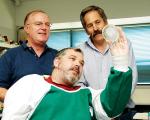Great contribution to food safety
 Biochemical Engineering Biochemical Engineering
Cheaper food with greater safety and improved nutritional quality: it sounds like every food shopper's dream and it's just what a team of University of Adelaide researchers are helping bring about. Their research uses mathematical modelling to produce quantitative risk assessments, rather than the traditional subjective risk assessment, for food safety in a range of industries from egg production through to aquaculture and brewing. Dr Connor Thomas, Associate Dean (IT) in the School of Molecular and Biomedical Science, and Dr Ken Davey, Senior Lecturer in the School of Chemical Engineering, first combined their expertise in the early 1990s to launch biochemical engineering studies. Since then they've brought in other University of Adelaide expertise (Biometrics SA) to establish the Food Research Group and formed a collaborative alliance with the South Australian Research and Development Institute (SARDI) Food Safety Research Program. "Our research interests were in food and allied food microbiology," says Dr Thomas. "We started a new field of microbiological process modelling by integrating basic chemical engineering principles with microbiology." Dr Davey adds: " We use mathematical modelling of biological processes to make predictions about food quality, for example bacterial growth, and then this is used to optimise the design process for the production of safe food, for example using sterilisation, pasteurisation or UV disinfection. "The great success of the SARDI collaboration has come about through bringing together our predictive capabilities and SARDI's industry links." Their work has not gone unnoticed. Just last month they joined a prestigious gathering at Government House in recognition of the collaboration's recent SA Great Science and Technology Award. This followed on from last year's Premier Award for Excellence in Research for Public Good. - Also honoured in the recent SA Great Awards was the University of Adelaide's cereal breeding team led by Dr Tony Rathjen, Mr Gil Hollamby, Dr David Sparrow and Professor Andy Barr. They were highly recommended in the Science and Technology category for their contribution in collectively breeding, developing and commercialising varieties of wheat and barley that occupy over 90% of the South Australian area sown, over 70% of Victoria, 50% of southern New South Wales and 10% of Western Australia.
Story by Robyn Mills
|





